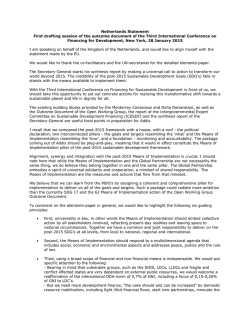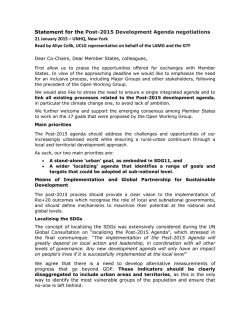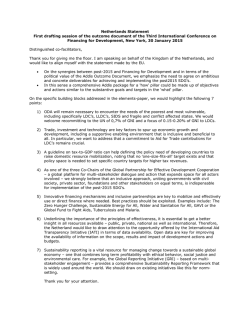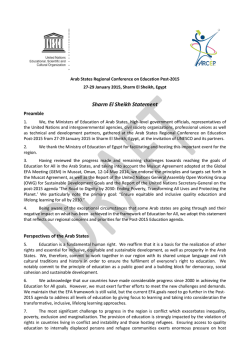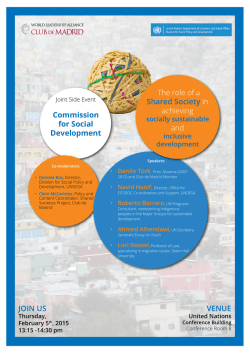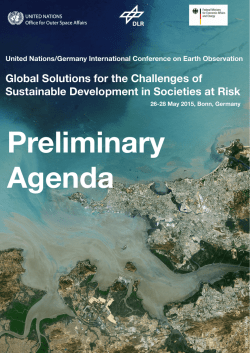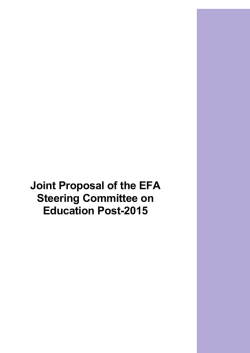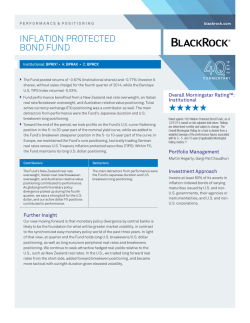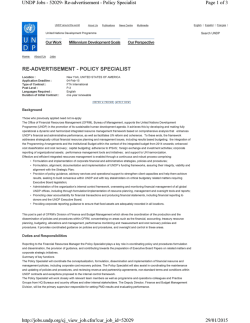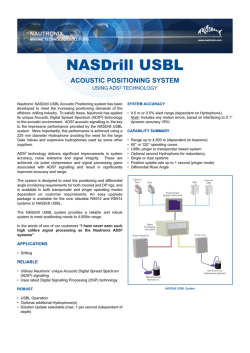
CHECK AGAINST DELIVERY 1 Helen Clark, UNDP
CHECK AGAINST DELIVERY Helen Clark, UNDP Administrator and Chair of the UN Development Group Special presentation at Dialogue on the longer-term positioning of the United Nations development system (Session II) Friday, 30 January 2015, 10-11 am ECOSOC Chamber I welcome the opportunity to address this ECOSOC dialogue on the longerterm positioning of the UN development system and I thank H.E. María Emma Mejía Vélez, Vice-President of the Economic and Social Council and Permanent Representative of Colombia for her introduction. 2015 is a huge opportunity in our common mission to advance the global sustainable development agenda. The MDGs run their course at the end of the year, and UN Member States are due to agree in September on the Sustainable Development Goals which will guide global development priorities over the next fifteen years. Alongside this process are other critical ones, which will cumulate in major events throughout the year: on disaster risk reduction; on financing for development; and on climate change. 2015 also offers an historic opportunity to shape the future role of the United Nations to ensure that we can contribute effectively to implementation of these major global agendas. Through the QCPR resolution in 2012 and in discussions around the Post2015 agenda, Member States have been clear that they want a UN development system which is relevant, nimble, and able to help countries deliver on their sustainable development priorities. To be fit for purpose in a post-2015 world, the United Nations must build on its successes and comparative advantages, and overcome remaining institutional and operational obstacles to delivering collaboratively. To this end, the UN development system is taking a comprehensive look at its objectives, priorities, operations, and funding, to ensure that it is well positioned to support achieving sustainable development. 1 CHECK AGAINST DELIVERY In my remarks today, I will highlight the main entry points through which we have been overhauling the system to date; I will brief you on a number of initiatives which we will be taking over the course of 2015; and, finally, I will look to the future and discuss the broader long-term positioning of the UN development system. Critical reform efforts to date Taking an integrated approach to addressing poverty, vulnerabilities, and resilience not only requires national governments to work across ministries and sectors; it also means that development actors, including the UN, need to be better at joining up their efforts and pooling their expertise and resources. Through its experiences in Delivering as One and self-starter countries, UN Country Teams have learned a lot about working together to provide relevant and cost-effective support for countries tackling complex and cross-cutting development challenges. More and more governments saw the value of having a joined up UN system in their country. 43 countries have adopted the DaO approach as the business model of choice for the UN Country Team. Many more have been using elements of it, adapted to their specific country context. Indeed, in the latest QCPR Monitoring Survey of Programme Countries conducted by UNDESA: two thirds of programme countries said they were interested in implementing some or all of the elements of the Delivering as One approach; 78 per cent of Delivering as One countries said there was less duplication of UN effort as a result of DaO; and, 73 per cent of Delivering as One countries confirmed that the approach made it easier for them to deal with the UN system (with the remaining 27 per cent saying it was too early to tell). This feedback from the survey confirms that the Delivering as One approach was on the right track. Now, as called for in the QCPR, the UNDG has introduced Standard Operating Procedures for UNCTs to deliver collaboratively. These were 2 CHECK AGAINST DELIVERY agreed across all UNDG entities, and have been signed off by the Secretary-General as the way of working in the post-2015 world. The whole point of the new procedures is to ensure that working together the UN development system helps to get results for the people and countries we serve. With over eighty UN Development Frameworks due to be finalized in 2015 and 2016, the SOPs provide essential guidance on how to get quality UNDAFs and implement them, and get results, which can be evaluated and reported on. The SOPs are flexible, and can be adapted to every national and UNCT context. They are the new way of doing business for all UNCTs. While we are accelerating implementation of a second generation of Delivering as One, the UNDG is also drawing on a range of good practices from around the world to ensure that the system is well prepared to deliver on the new development agenda. For example: We have been piloting a new, integrated Business Operations Strategy in thirteen countries – focused on making us more effective and efficient. The estimated cost savings in ICT, human resources, and other common services are significant. In Ethiopia, for instance, we are estimating over $12 million in cost savings over three years, while savings in Rwanda are estimated to be $15 million over five years. In Malawi, we have been working with the government to develop an innovative monitoring framework which generates real-time data on the implementation of the UNDAF. This will allow the UN and the Government to identify bottlenecks quickly and take corrective action to keep UN programmes on track; The new UNDG ‘Delivering Results Together’ Fund has become operational. It promotes integrated and coherent policy responses to support MDG achievement and advance sustainable development. In Bhutan, for instance, it has allowed UNICEF, ILO, and UNDP to support jointly the roll-out of a social protection floor in line with the national action plan. While considerable focus has been given to improving the way we work together at the country level, we are also strongly focused on making headquarters better equipped in the post-2015 world. 3 CHECK AGAINST DELIVERY Guiding this work is the fundamental principle that our work at headquarters must always be well grounded in the needs of country-level operations. Key initiatives in 2015 This year, the UNDG will undertake several key initiatives in preparation for the implementation of the post-2015 agenda. These include: 1. Piloting the next generation of MDG Acceleration Frameworks to make progress on lagging MDGs and prepare for implementation of the post-2015 agenda; 2. Looking at how to promote improved collaboration between humanitarian and development actors, including how to support programme countries to co-ordinate humanitarian and development work better; 3. Improving our programming and funding instruments, including pooled financing mechanisms, to give better support to countries in early recovery and transition. This also means bringing together development and humanitarian financing where that makes sense; 4. Developing a new risk management framework for pooled funding. This will allow us and our partners to identify and manage risks while continuing to support development, even in high-risk environments. We will aim to take a system-wide approach to assessing risk and promoting resilience; 5. Accelerating the mainstreaming of South-South and Triangular Cooperation across the system. This is now supported by a new UNDG co-ordination mechanism on South- and Triangular Co-operation, co-led by the UN Office for South-South Co-operation; 6. Putting in place a new learning and performance management system for a stronger Resident Co-ordinator system, supported by a system-wide cost sharing system. The latter covers only a small share of the costs of the system, with UNDP contributing around three-quarters of the total costs, in line with its leadership role in system co-ordination; 7. Supporting countries to ensure their data and evidence can be used more effectively and systematically. This also entails emphasis on 4 CHECK AGAINST DELIVERY supporting national data and statistical capacity development to support SDG implementation; 8. Stepping up our efforts to be more consultative, not only with central state authorities, but also with parliamentarians, local governments, civil society, the private sector, and other national actors, building on the momentum of the post-2015 national consultations across close to 100 countries and the global survey responses from more than seven million people. Taken together, we are confident that these key initiatives will see the UN development system well placed to support implementation of the post2015 agenda, and to strengthening the longer-term position of the UN development system as a key and relevant actor. Longer-term positioning of the UN development system Looking beyond 2015, the UNDG has recently agreed on a common vision1 on the longer-term positioning of the UN development system. Formulating this common vision was the beginning of a process, which will see us build on all our reform initiatives so far, and undertake others to make the system fit for purpose for post-2015. To support sustainable development around the world, we need: a UN system which supports countries to meet the international commitments they make, provides platforms for global discussion, and helps design and implement practical solutions on the ground; a UN development system which firmly grounds its work in cuttingedge analytics and strategies focused on tackling inequalities, lack of rights, and vulnerabilities and risks; more open and common systems for the production, sharing, and use of quality data, knowledge, and practices across the UN system and with other partners; results-based, well-networked, and highly professional teams which collaborate and interact with all relevant stakeholders. “UNDG Vision and Framework for Actions for UN Operational Activities in support of the post2015 Agenda.” 1 5 CHECK AGAINST DELIVERY Operationalizing this vision will better enable UN Country Teams to codesign programmes with stakeholders, provide platforms for shared capacities and operations, and be a lead actor in facilitating nationallyled dialogues. The performance and results of institutions and individuals will be able to be evaluated thoroughly and transparently. These elements form the thrust of UNDG’s vision for the longer term positioning of the UN development system. We look forward to taking this vision forward with Member States within the context of this ECOSOC Dialogue and in the lead-up to the next QCPR. We do believe that the discussion about “fit for purpose” must go beyond what is possible through the current architecture, resources, technologies, and human capacities of the UN, and look to a bolder UN which will deliver on its new mandates through broader partnerships. Conclusion Allow me to conclude by emphasizing again the critical importance of 2015 for global action on development, including for the future role of the United Nations. Then, in 2016, against the backdrop of a newly adopted development agenda, the General Assembly will, through the new QCPR, decide on the future strategic direction of the UN development system. At the UNDG we have made significant changes in our way of working and are well positioned with your countries’ leadership to deliver on the post2015 agenda. Let me reaffirm, that we are well positioned to lead in the UN system on implementation. We look forward to working with Member States to make the most of the opportunity which the new QCPR bring. We hope that it will look at the whole system and strengthen its ability to deliver meaningful and sustained development results in the post-2015 world. 6
© Copyright 2025
